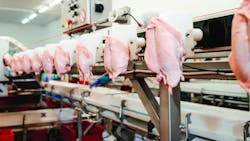Few people with knowledge of the history of the food industry in the U.S. would say the relationship between the government and meat and poultry processors ever was a match made in heaven. Some of the tiffs have led to revolutionary changes that have withstood the test of time. Others less so. And there have been times of peaceful collaboration and coexistence.
These days appear to be a time of trial and tribulation again, with the regulatory microscope returning to processing plants. In February 2023, for example, the Dept. of Labor (DOL) discovered underage workers — more than 100 in 13 plants owned by nine companies across the country — employed illegally by Packers Sanitation Services Inc. (PSSI), a third-party contract sanitation service used by many of the mega meat companies. The government embarked on a mission to root out and eliminate child labor violations throughout the industry.
USDA warned the 18 largest meat and poultry processors in April 2023 it would be supporting DOL’s efforts, saying it would use its “procurement and regulatory authorities to provide the necessary attention and increased oversight to curb this recent trend as quickly as possible.”
Unfortunately for some processors, the magnifying glass has not been kind. Several meat and poultry companies have been investigated and found in violation of child labor laws. Furthermore, just last month another third-party contract sanitation company was under investigation by the DOL for child labor violations.
Meanwhile, the Environmental Protection Agency (EPA) unveiled proposed guidelines for wastewater effluent in meat and poultry processing operations that has the industry on edge. EPA released the “Meat and Poultry Products Effluent Guidelines - 2024 Proposed Rule” on Dec. 15, 2023, putting to rest months of anticipation and concern for small meat and poultry processors, who feared the worst.
“AAMP is encouraged by the work EPA has done in the development of the proposed rule to protect the small business entities … ,” Chris Young, executive director of the American Assoc. of Meat Processors (AAMP) said at the time. “We are happy to see EPA responded to our concerns and minimized the impact of the rule on those businesses.”
However, with the public comment period open until March 25, AAMP has worked hard to keep the industry in support of the rule as proposed — in response to voices that believe the proposed rule doesn’t go far enough.
“Environmental activists are free to leave their comments as well, and one of the groups that the EPA cited in its findings has stated that the agency’s proposal doesn't go far enough,” AAMP said in a statement distributed via email. “If the activists get their way, the EPA’s actual guidelines on effluent discharge could force small processors to spend millions on wastewater treatment equipment or cease operations.”
Angling to automate
Certainly, processing plants offer some of the most challenging workplace environments, and as such, the ongoing labor shortage has deeply impacted meat and poultry processing plants. Of course, companies have seen this before and have been making changes to address it, says Brett Erickson, director of Prepared and Packaged Solutions for Certified Angus Beef.
“Labor is still a big issue, because it's either too expensive or you can't find it,” he says. “A lot of processors are looking at how to eliminate those positions in the plants — what equipment is out there today that does the work that I need without the labor?”
Cutting, trimming, cooking, chilling and product movement have all seen innovations that have helped processors solve those issues, while improving upon yield and efficiency setbacks or bottlenecks in past iterations of the technology.
The goal today -- aside from minimizing the need to hire, train and retain people who simply don’t want to work in meat plants -- is to set up the lines and plants to produce more capacity with more efficiency, Erickson adds, but also less downtime at different points in the plant. Processors want to know how they can best streamline the plant’s setup and operation, and they’re looking to technology to help them.
In fact, the pump may be primed for further investment. Recent industry trade shows have produced good attendance (both reported and anecdotal) and generally positive reviews from exhibitors overall — where exhibitors have confirmed that the “right” people were visiting their booths, not just kicking the tires. Does this mean the pocketbooks are opening and processors are going to be renovating, expanding or building new processing plants? Well, some of the headwinds may have a say about that before 2024 ends.
Experts aren’t predicting exploding demand for meat and poultry products, and in fact, many of the market analysts we’ve spoken with in the past four to five months expect some reckoning still coming the way of animal protein. Certainly, supply chain kinks have been worked out, and although inflation hasn’t vanished, it has eased. Consumers seemingly grew tired of constant price increases and finally began to trade out of higher-priced food items, including some meat and poultry cuts.
To get a good idea of the peaks and valleys the industry has seen in the past year, one only needs to look at Tyson Foods. For its fiscal 2023, Tyson posted a $648 million loss, quite a reversal from the $3.3 billion profit of the year before. The company has made significant alterations to its processing structure, closing about a dozen plants (mostly chicken processing) and laying off hundreds of workers to respond to weakening demand in chicken, pork and beef. But it also made acquisitions (Williams Sausage) and opened a new bacon processing plant in Kentucky.
Tyson recently reported its first-quarter earnings for 2024. Sales inched up less than 1% but the company did eke out a $114 million profit.
Plant-based and alternatives stalling?
For plant-based and alternative protein companies, the ups and downs haven’t been any more forgiving. From a processing perspective, the seemingly agonizing wait for processors to scale up production and build facilities to mass-produce their products appeared to finally be reaching an end.
Upside Foods, a maker of cultivated chicken, announced last fall that it would build a full-scale production facility in suburban Chicago shortly after getting USDA approval to sell its chicken product in the U.S. But just last month, those plans were put on hold.
Other companies hit seemingly significant milestones on regulatory approval, building smaller scale facilities and announcing distribution plans for the U.S. However, at the same time, the warning bells began to ring for many of them, whether they heard them or not. Once the up-and-coming darlings of the industry, a lot of these companies have seen the air escape from their balloons heading into 2024.
Billy Roberts, senior economist for food and beverage at CoBank discussed in an August 2023 report how plant-based meat alternatives had reached a tipping point, with even loyal consumers turned away by higher prices and other consumers balking at negative perceptions around the taste, value and versatility of plant-based alternatives.
“Whatever their reason for purchase, plant-based offerings appear to have fallen short of consumers’ expectations in terms of either cost or performance,” Roberts said at the time, adding that innovation around taste, texture and mouthfeel was essential to the future of the product lines.
Beyond Meat and Impossible Foods are just two companies that laid off a sizeable portion of their workforces in the past year. At presstime on this story, Beyond Meat announced its fourth iteration of its Beyond Burger — said to have revamped the health, taste and clean-label attributes of the product.
Smaller players such as Tindle Foods, Meati Foods, Omeat and others, have had various ups and downs, including layoffs and executive team adjustments. All this, however, stands in the face of Circana data showing that meat alternatives’ retail sales year-over-year (as of Jan. 28, 2024) were down 33.6%.
The crystal ball for any portion of the meat and poultry industry may be cracked, as there isn’t really a clear answer for what the future holds. Although some companies appear to be pulling the correct levers and succeeding, there appear to be just as many grasping for straws.
Innovative operational strategies and equipment will continue to develop, but implementation and installation slow when processors feel threatened. On the operations side, this uncertainty hasn’t seemed to stymie innovation or advancement just yet, but as history often has shown, the meat and poultry industry doesn’t typically throw financial caution to the wind when it’s blowing in a way it struggles to gauge.




